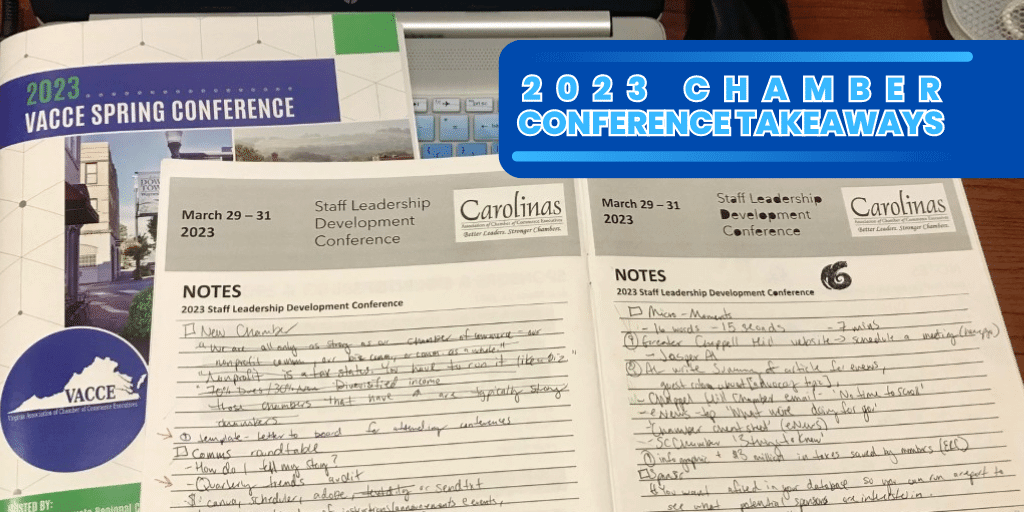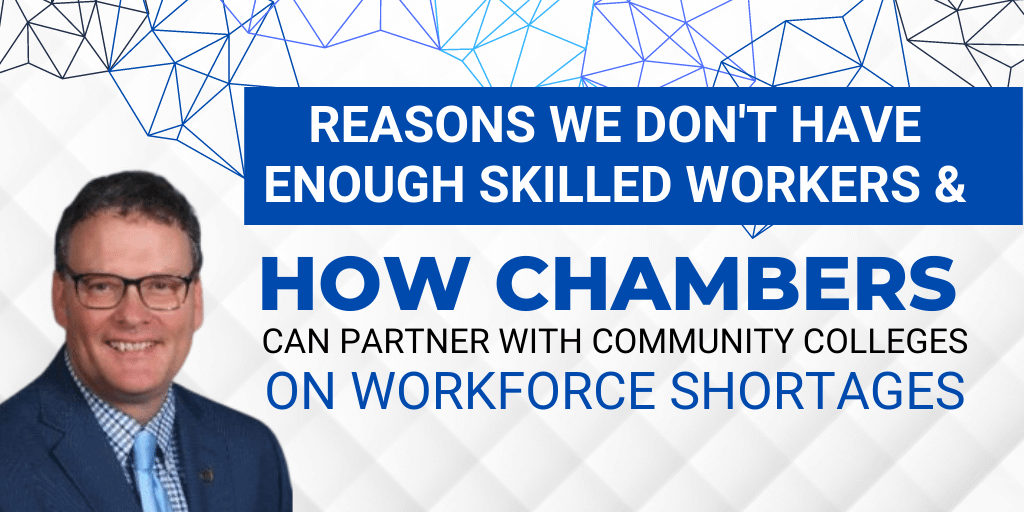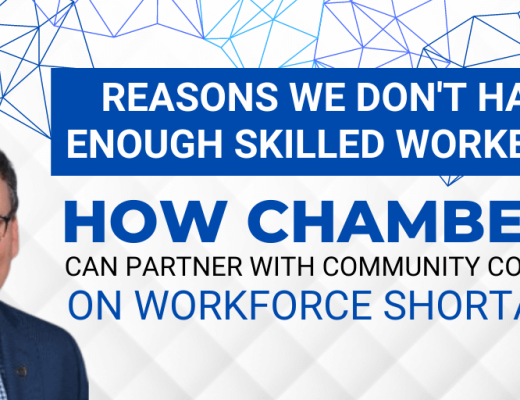I attended the spring conferences of the Virginia & Carolinas Associations of Chamber of Commerce Executives and always, there was so much great information for #ChamberPros shared! Below I’ve consolidated my conferences notes so you can hopefully glean a takeaway from these amazing conferences, though I highly recommend attending one yourself!
You can see your state’s similar association or check out another states. Yes, you can attend another states conference – you would just pay a non-member rate. I recommend CACCE since it’s two states combined. Or, check out states you want to travel or have family nearby.
Marketing
Top Technology:
Most of us are using:
- Canva (both paid & free)
- Social media scheduler (any scheduler is fine, just schedule it!)
- an Email Marketing Provider (reminder: Constant Contact is free for chambers up to a certain amount of contacts)
- A CRM (like ChamberMaster or other)
Some are using:
- Texting (keep reading for more)
- Adobe Creative Cloud
- AI (article TBA)
- Mentimeter
PS: If you have a (c)3, get a TechSoup account for free/discounted software.
Different Marketing Mediums, Different Audiences
Not gonna lie, this quote hit home:

Sandy made an excellent point, so let’s talk about it. A lot of chambers send out way too many emails. And some of those chambers even keep resending all their emails all the time, just adding to it. I myself even delete most emails from a particular chamber I’m a part of because of this. By not communicating what or how your audience is interested in, you’re subconsciously training them to not be interested in you.
So how do we change, but still share the information we need to get out?
- Utilize different mediums / Meet them where they are
If you’re not engaging members through a particular medium (email, Facebook, etc.), then try a different one!
Many #ChamberPros at both conferences talked about video newsletters. For this, they simply record a ‘talking head’ (aka a video of a person talking, with little to no editing) summarizing points in the email newsletter. Instead of resending the email newsletter, or complaining about people not reading it… #guilty – they found another way to share the information.
These video newsletters seem to be a growing trend that’s working well. Speaking of which:- Don’t re-send (all) mass emails
There’s a cool feature in email marketing providers now where you can re-send an email to non-openers. However, it’s quickly become abused. If people are not opening emails, there’s probably a reason. And if you’re going to re-share the information in a future email anyways, then you’re just overwhelming inboxes.
Instead, only use this feature on really important communications, and no more than once a month.
Or consider resending information manually, and only to a more targeted list. This is an example of:
- Segment your audiences
There are numerous ways to segment your audience.
As an example, let’s continue with the idea of re-sending an email to a segment of an audience. You might only re-send an email about sponsorship to those that clicked on the PDF sponsorship guide in your previous email using the Click-Through report and creating a new segment or list of just those people.
Or you might only send a Membership Orientation email invite to emails who have been added to your membership list in the last 90 days (using the segmentation option in Constant Contact). Your other members aren’t excluded because you still list the event in your eNewsletter, but you’re not sending an extra email to those that likely aren’t interested.
- Schedule what you can
I’ve been saying it for years, so it feels nice to hear others say the same:
<br></br>When you create a ‘content calendar’ or ‘posting plan,’ you’re basically creating a checklist for your social media. This makes it easier to schedule posts ahead of time by batching content. This saves you time & stress later!
Email Marketing
Subject Lines
Most talk of email marketing was on subject lines. The goal of your subject line is to get someone to open your email. Then the goal of the first lines of most emails is to get them to read more of the email.
Most of my subject line recommendations all fall under one consideration: ‘What’s in it for me?’. No one cares that the email comes from the chamber. People care about what affects them or what can help them.
So focus on delivering content that fills their needs, and then craft your subject lines to get people interested in opening your emails.
Fill out this form to download my chamber-specific list of subject line examples & fill-in-the-blank templates:
Email Examples
- No time to scroll
The most praised email mentioned at CACCE was the ‘No time to scroll’ email from Chapel Hill Chamber (NC). They simply bullet point topics that link to more information. The email itself therefore is very short – in fact so short it doesn’t scroll.
I think this is a great example of trying out different formats. Be sure to pay attention open rates, click through rates, and verbal feedback on different types of emails.
‘No time to scroll’ is innovative within the chamber world because we all send such lengthy newsletters that nobody reads to the bottom of, but on the other hand, content-first emails that provide value can help build relationships. In short, there’s no single best email for all of us, but experimenting can lead you to what’s best for your audience.
- 3 Things to Know
The SC chamber sends a weekly email called ‘3 things to know.’ It’s literally 3 topics with about a paragraph of information on each.
As a chamber staffer I regularly looked for this email. Even by just glancing at the topics, I knew what was timely/topical. Sometimes topics were repeated, and that’s okay. It was short enough that it wasn’t overwhelming, which is hard to do. They do a great job at making it skimmable.
Texting
Yes, some chambers are using texting.
The biggest concerns are:
- Not utilizing it enough or in the best way
- Segmenting can cost money because you need to buy more numbers or codes (as opposed to email, where you can have multiple email lists in one account)
Those that do use it say their numbers are small, but that can actually be a good thing as you’re not unintentionally ‘annoying’ people not interested in promotional texts.
Best practices seems to be 1) segment and 2) timing/use.
For segmenting, think about the type of texts you might send. Not everyone wants event invites over texts. You might create lists for business events, events/tips for locals, or timely news/update (note: actual news – not just your newsletter).
For timing & use, think about when you’d want to receive a text. For example, I might like an email event invite 2 weeks before the event, but a text reminder an hour before it.
Another chamber (I’m sorry I forgot who) used texting during a large golf event to send out updates/reminder like where to go or what’s next on the agenda.
Tell Your Story
A common question I hear is, “How do I tell the Chamber’s story?”
While there are so many ways to answer that, I’m going to say: by humble-bragging.
Talk about yourself. Talk about the chamber. Share your successes. Share your milestones. Talk about anything you can. Specific examples might include:
- Get testimonials! It’s not just you telling you’re story – it’s the people you’ve helped!
- Whip out your phone and ask someone if you can record what they said when they’re telling you something nice about the chamber
- Solicit quick video testimonials while networking at events
- It’s not just membership – what programs have you helped with? How have they impacted your community?
- Structure radio ads to naturally include a testimonial
- Promote that you’ve had a hand in community projects with images on social media and create a history with a Reinvestments webpage
- Public policy updates (more than just your ‘legislative priorities’ pdf…)
- Presentation recordings
- Sharing a picture of a meeting with an elected official on social media. Even if you don’t share all the details, you can say ‘We met [person] about [topic.]’ Even if you’re not at the success stage, you can showcase how you’re taking action!
- Share brief updates or talking point during event announcements
- Create short content to actually explain why something is important (“explain it to me like I’m 5”)
- Don’t just tell us that something was a success. Explain why or how.
- Keep in mind your audience and relate it directly to them. Example: If it’s an economic development issue, how does it affect the average citizen?
Marketing Staff Talk Money
Much of our round table discussions around marketing were not actually about technology or best practices, but instead on the demand/need for revenue.
I recommend building sponsorships into everything you do. If you’ve had Pat McGaughey as an instructor at IOM, you know that if you get creative you can get sponsors for anything – from limo rides to port-a-potties. In the past I’ve managed to get small ($500) sponsors for Ribbon Cuttings on Facebook Live, logos on business tip videos, etc.
Speaking of which – Ribbon Cutting sponsorships/paid packages are a thing! If you currently don’t charge for ribbon cuttings, then think ‘freemium’ options. Examples: Greenville Chamber, Arlington Chamber.
Along a similar train of thought is to create marketing & advertising opportunities. You can still offer ‘free’ or low-cost options to members, but you don’t need to give everything away! The value of membership goes beyond services that are easy to assign dollar amounts to.
I also recommend getting in the habit of using all of your ad spaces – even when you don’t have a paid partner. You can promote other chamber programs or affinity partners. By doing this, potential advertisers can see the ads in action, creating demand. Additionally, you further your own needs by promoting your other programs or highlights that you might otherwise forget to actually promote!
For larger amounts of money, I recommend simply thinking bigger. April Bragg of the Robins Regional Chamber (GA) is a great example of this.
During COVID when things were hard, April & her team went harder. They created a highly engaging Facebook community that promoted all area businesses, but highlighted members, and even made some non-dues revenue. They also had/have virtual shows / videos that performed well and generated thousands of dollars in non-dues revenue. For examples, check out their Facebook videos and look for anything with a logo!
Membership & Programs
Chamber Income
Chamber superstar Anissa Starnes recommends having diversified income. She finds that ‘chambers whose income is at least 30% non-dues revenue are typically strong chambers.’
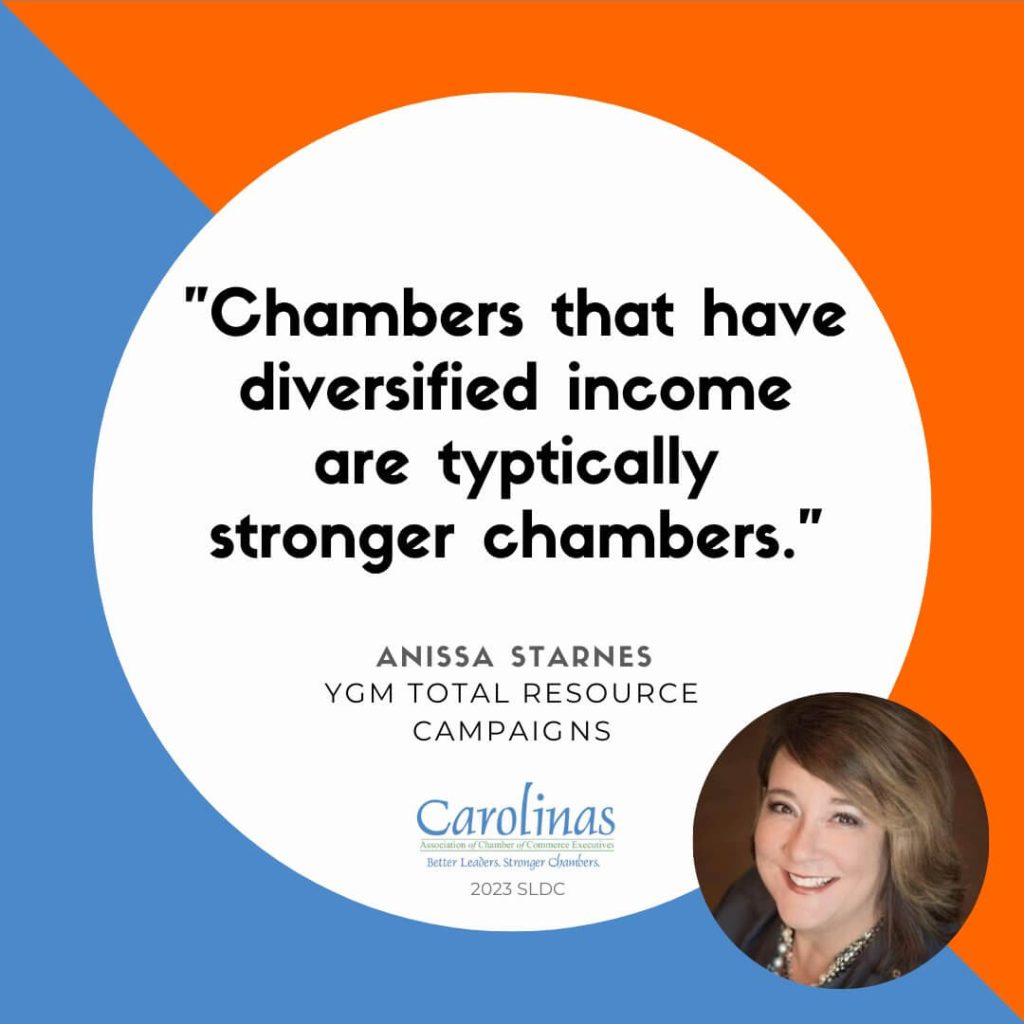
To increase non-dues revenue, you might want to create advertising opportunities for members, join an affiliate partner (think paid affinity program), or simply better promote your existing partners. I also highly recommend creating a Chairman’s Circle or One-Ask Sponsorship, both of which I talk about more later in this article.
Raising Membership Dues
Many chambers talked to each other about concerns on raising dues. Most understand the needs to raise dues, even raising dues every year by a consistent amount or percentage. This helps you fight inflation & rising costs, just like any business would. The need is there for almost every chamber, but the biggest barrier to change tends to be the board not wanting to change things. However, by not making incremental changes, you will eventually have to make a larger change that is much more noticeable (and possibly shocking) to your members, particularly smaller businesses that are our transactional members.
The best advice given is to use data to support you, and ask if your board would still ignore the advice within their own business.
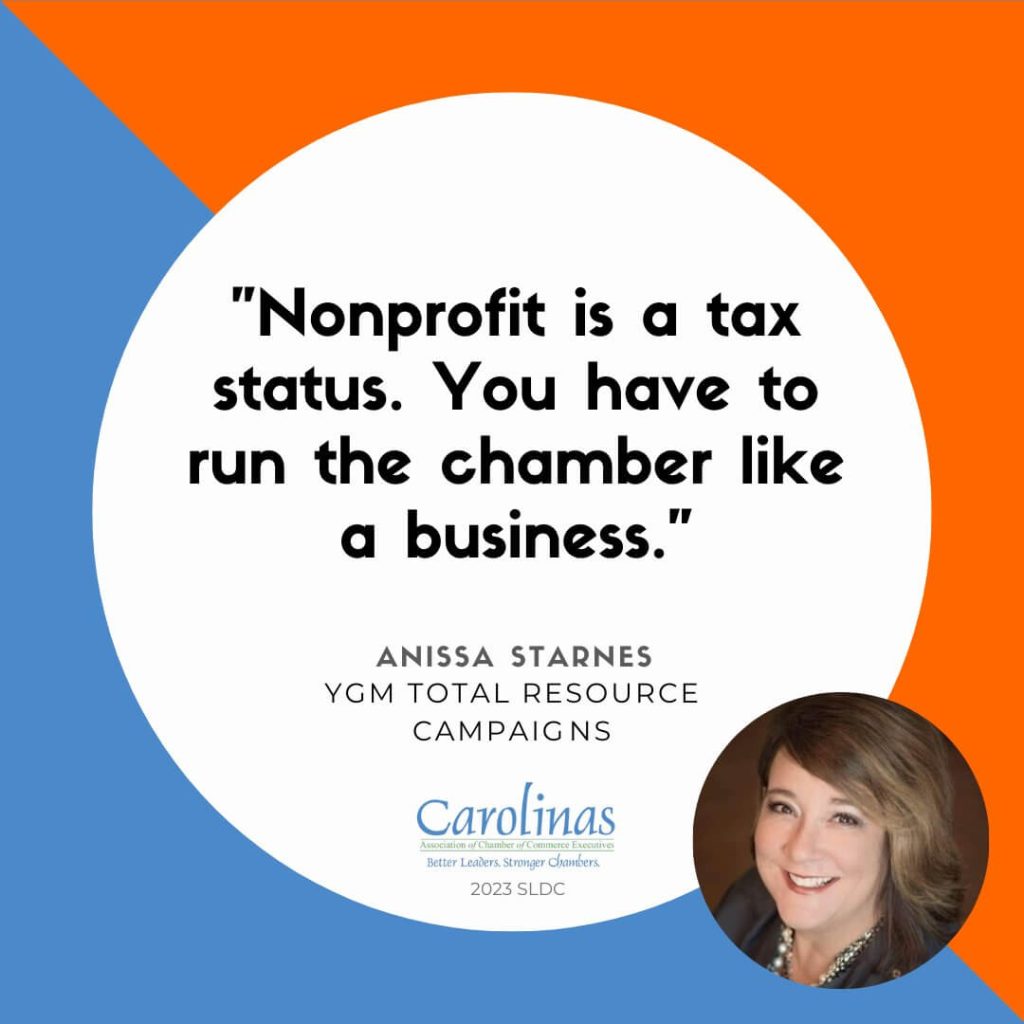
Take your operating costs, and divide by number of members.
Operating Costs / # Members = Cost to Support 1 Member
If your operating costs are $150,000 and you have 200 members, then it costs you $750 to support a member. Would your board members operate their business at a deficit?

Another mindset shift that Todd Bradberry brings up is ‘Service is profit.’
Just like a business, you provide a service. And your service with worth money. And you can not continue to provide that service if you are not profitable.
Chairmans Circle (You should make one) $$$
An excellent source of ‘big-fish’ sponsorship is implementing a Chairmans Circle / Presidents Circle / Chamber Champions program. This is an exclusive (limited number), high-priced sponsorship for the year. This is more likely sponsoring the chamber itself instead of a specific program.
Examples:
- Cartersville-Bartow County Chamber ($1,000 – $10,000)
- Bainbridge Island Chamber ($1,500 – $10,000)
- Newton Chamber ($2,500 – $10,000)
- Ventura Chamber ($2,500 – $15,000)
- Fuquay-Varina Chamber of Commerce ($3,000 – $10,000)
- Palm Springs Chamber ($5,000 – $20,000)
- Jimmy Fund / Dana-Farber Cancer Institute ($1,000 – $99,999)
Benefits should focus on exclusivity, being perceived as or feeling special, making things easy, etc. This might include:
- Sponsor logos included at the bottom of chamber newsletter, CEO’s email signature, on event signage, or other places that you can update once but would be used throughout the year.
- Exclusive access, like to the CEO, board members, event speakers, VIP events, etc.
- Exclusive event opportunities – like short speaking time at various events, special recognition, opportunity to include literature or items at events or in bags, opportunity for table (even at non-vendor events), etc.
- Just make it happen – free use of things you might otherwise nickel & dime for, like use of your conference room.
- Priority – seating, early admission time, advanced registration to events that sell out,
The list is short, and for a reason. We’re not going after all of our transactional-minded members. We want big money, big impact people. Some chambers create sponsorship tiers, but you can even try a single, high-priced sponsorship limited to 10 or 12 people. Personally, I think you shouldn’t charge less than $1,000 and your goal should be getting 5-digit sponsors ($10k), or just increasing whatever you think is too expensive – you’d be surprised what works out! You should NOT be trying to make this affordable – that’s for membership.
One-Ask Membership/Sponsorship (Annual Partners)
Sometimes this blurs the lines with the Chairmans Circle, but this is more about combining membership and sponsorship so you’re only asking for money once a year. This also makes it easier for businesses to plan – so hit them up in early winter so they can budget for the following year!
Examples:
Like to include event tickets/sponsorships/tables/etc. as a one-ask sponsor benefit? A very smart chamber includes 10% of sponsorship value as a chamber ‘gift card’ that can be used towards any event or sponsorship.
Greenville (SC?) Chamber uses Accrisoft as their CRM and the gift card is set up by staff and applied to their account. Anytime they want to register for an event or sponsorship the balance is automatically applied at checkout. This lets the sponsor get exactly what they want, without spending a lot of staff time on follow-up & paperwork.
More on Sponsorships
Other tips from facilitated breakout sessions:
- Create a custom field in your database/CRM so you can run a report to see what potential sponsors are interested in. This would be a text field where staff can make notes.
- “First right of acceptance” sounds better than “first right of refusal”
- Exclusivity is a way chambers can take advantage of FOMO. Exclusivity & limited availability helps sell.
- If someone wants to be an exclusive industry sponsor (the only one in their industry to sponsor) then they need to pay more! Consider the ‘opportunity cost’ of not being able to accept additional sponsors (whether or not they’re lined up). You should charge at least double.
- Again, you can work with your marketing staff to have them send an email click-through report to generate a list of contacts that clicked on the link to your sponsorship PDF. These people are practically warm leads to follow up with about sponsorship.
- Not that anyone asked me, but I think a great idea for sponsorship sales staff trying to work with transactional-minded sponsors is to encourage them to use their digital logo placement as a lead magnet. For logo placement online only, instead of using their regular logo & main website, have them submit a small (logo-sized) image that promotes their lead magnet and a the url to their landing page. For people that see their logo online and are more likely to be a potential customer, they’re more likely to click on the relevant logo than just another business logo. This can help the business generate warm leads in addition to their other brand awareness benefits.
- Some chambers have seen success with sponsors that want to pay & support nonprofits or minority-owned businesses, but don’t want credit.
- Table sponsors – ask sponsors if they want a table reserved for them, or if they want that many tickets and their guests can sit where they want.
- If you want more mission-driven sponsors, then you need to communicate mission-driven results. A great line I heard was ‘When you invest in xzy level, you supported # sponsorships,” or “When you buy abc, this is how we used your money.” Even if you don’t have exact numbers, just communicating what you do know or are working on can go a long way!
Event Tips
- Use a tool like Mentimeter & QR codes to get attendees to fill out surveys while they’re still at the event. Chambers that had these posted noticed many more survey submissions than previously recorded.
- Create a volunteer catalogue and/or form – in addition to regularly office volunteers, you might just want a list of people you can call on to help set up or work events. See this post for more on volunteer ideas.
- I liked the idea of recap videos – talk about why the event was a success. Keep in mind different audiences – what is success to a sponsor? Attendee? Very different videos.
- Invest in area photography & drone footage of key areas you might want to mention later. Especially if you’re already working on a similar project, go ahead and scope out other areas in your community. Create an internal bank that you can pull from later.
- Personal weak point: want better videos? Consciously take video clips of ‘wide, medium, and tight shots’. This can make any video feel more interesting.
Strategic Planning
I particularly enjoyed Amy Hager’s Strategic Planning for Chambers and recommend working with her. Something she talked about were events/programs and whether they relate to the chamber mission. While this is a common discussion amongst chambers, I really appreciated they way she approached it with her chamber clients.
She had staff & board fill out surveys to grade events on: 1) Does it align with our mission 2) Did we excel at execution? 3) Community impact/relevance. We all know we should probably get rid of the events that score poorly for all 3 and keep the ones that score all highly, but my aha moment (that should of been obvious) is working on the ‘messy middle.’
Those are the ones that we actually want to get rid of or improve so that they score higher in those 3 ways. So instead of spending our limited time tweaking an already successful event, how can we revamp a messy-middle program so it better aligns with us?
Another a-ha moment for me was when she casually mentioned she has a chamber client that doesn’t do a board retreat, and she instead does their board training in pieces at each board meeting throughout the year. It’s so simple, but kind of blew my mind. ????
Small- vs Medium-Sized Chambers
At VACCE I attended the small chambers session, and at CACCE I attended the medium-sized chambers networking breakfast.
While the format naturally led to a difference in topics covered, I found that the medium-sized chambers at my table talked mostly about audits. The general importance, and also just how hard it is to find an auditor to hire.
Small chamber concerns included:
- Tiered dues – which I’m against IF your main goal is hoping you get more top-level investors. However the discussion proved to me that it can be great to set up uniform pricing & benefits. Some chamber’s pricing is unnecessarily messy.
- Nonprofit members – The best recommendation is to NOT be free & flexible. You’re a nonprofit, too! And these organizations tend to pay the least and require the most. Instead call it something different – like Charitable Organizations – and create a rule beyond just nonprofit. This might be for ‘nonprofits run entirely by volunteers.’
- Individual Memberships – are not popular and can confuse even chamber staff. Basically, Indvidual memberships are NOT for businesses. These are for individual to get communications & event invites (at member pricing). Think retirees. While they can network, they get no marketing opportunities or avenues (other than networking) to promote their business. Instead, most people actually need a business membership. So be clear about this! (Or better yet, just don’t even promote it.)
- Board FAQs – We’re not talking about the bylaws. Instead, these are FAQs that are not ‘official’ documents that need to be approved. These are provided as a courtesy to new board members to help understand their role, function, etc.
- CEO Expectations – similarly, getting a list of expectations from board members about their expectations for you can really help improve your relationship so you know how to communicate what they actually care about.
- Switching CRMs– Anyone will tell you that switching from any CRM is basically a big pain (even from Chamber Master to Growth Zone). Ask around for advice and be sure to get data backups. I’ve seen some chambers lose basic information like Join Dates when switching platforms. Do your research and try to pick a CRM you think you want to stick with for years to come – not just going with a cheaper option temporarily.
Community & Economic Development
Governmental Relations
As a marketing person, this is a bit outside my field, so I’ll just reiterate some basic advice:
- You don’t have to – nor should you – do it alone. Your partners can include: members, city or county or state leaders, elected officials, school or youth systems, and even other chambers. (Especially when you come together to form a Coalition)
- Resource highlight: Advocacy toolkit by Top of Virginia Regional Chamber
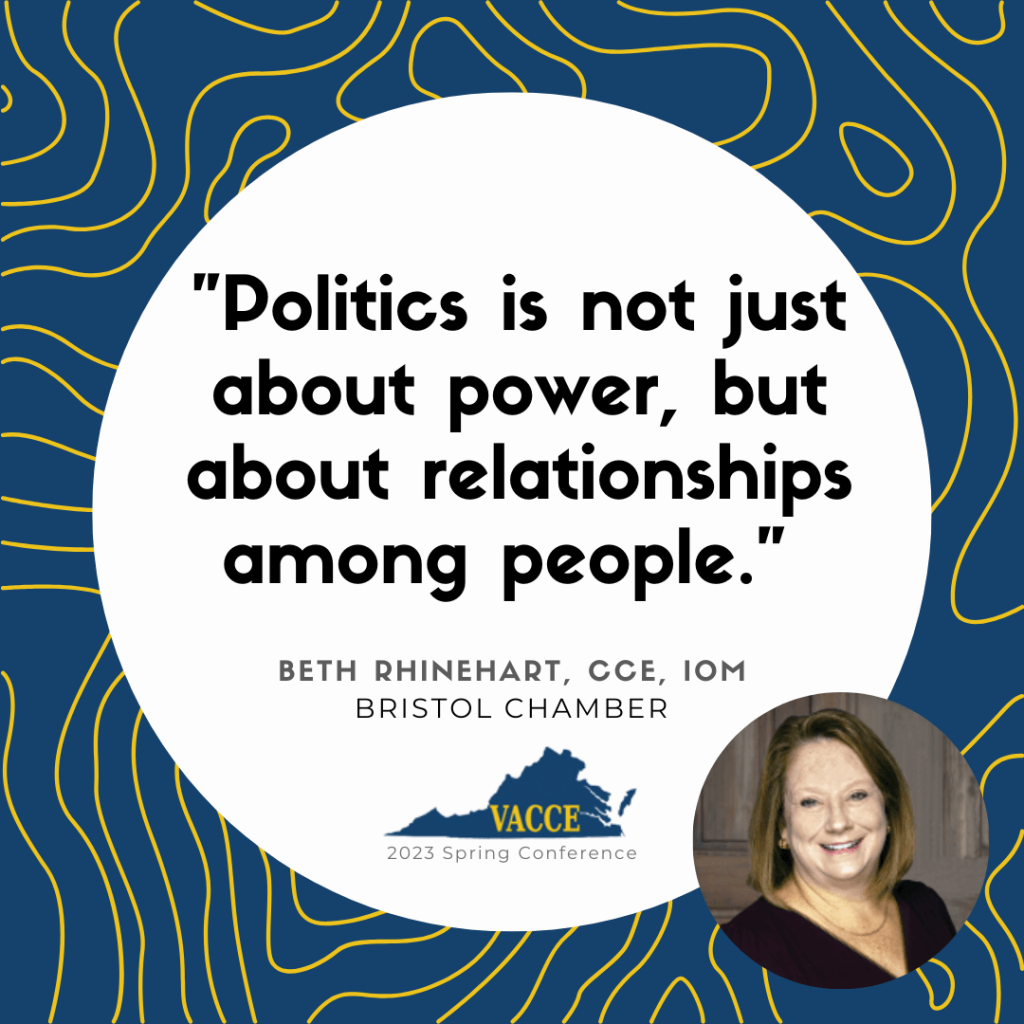
You can also utilize your marketing staff to help support your mission. Ideas:
- Government, politics, legislative priorities, etc. is confusing! Create simple, short videos that explain the point and how it can affect your audience (either local residents or local businesses).
- Marketing can also take points from the videos to create graphics to reuse, whether on social media, in print literature, etc.
- Train event staff to include an easy to understand (and remember) talking points of legislative priorities when they’re already making announcements at events.
- Create specialized webpages with your supporting documentation or additional information.
Workforce Trends: Challenges and Opportunities for the Future
Communities nation-wide are facing a skilled workforce shortage. Top causes include:
- Baby Boomers Retiring (at record rates)
- Greatest Historical Wealth Transfer
- Opioids & Substance Abuse Addiction
- Video Game Addiction
- Key demographic: men aged 25-34
- Women not returning after COVID shut downs, child care, & other demographic impacts.
- Birthrate Declines (less young workers than previous generations)
One way Chambers can help is by focusing on the ‘skilled’ part by partnering with key organizations. For more on this, Dr. John A. Downey shared his entire presentation with me:

